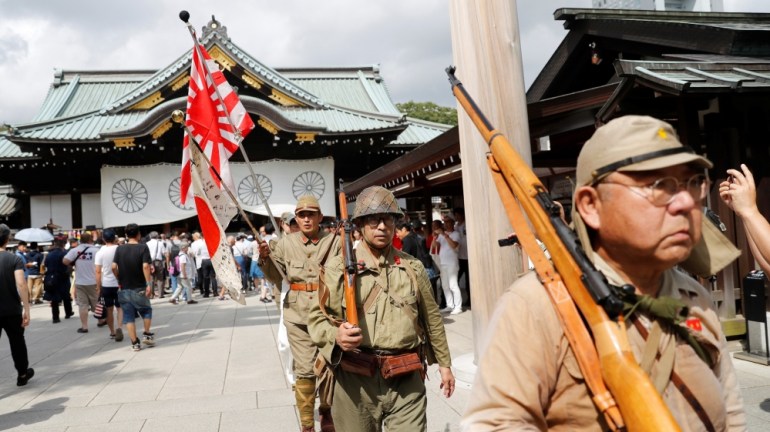Japan’s defence, economy ministers visit Yasukuni shrine
Shrine remains a potent symbol of Japan’s wartime legacy in East Asia and a flashpoint for tensions with China and the two Koreas.

Two senior ministers in the cabinet of Japanese Prime Minister Yoshihide Suga visited a controversial shrine in Tokyo honouring the country’s war dead on Friday, according to news reports, in a move that could increase tension with China, and South and North Korea.
Defence Minister Nobuo Kishi and Economic and Fiscal Policy Minister Yasutoshi Nishimura visited the Yasukuni Shrine where some of Japan’s convicted war criminals are interred, according to the Kyodo news agency.
Keep reading
list of 3 itemsSex slave statue sparks Japan-South Korea row
How possible successors stack up if Japan PM Abe resigns
Nearly 80 years after Japan’s defeat in World War II, the shrine remains a potent symbol of its wartime legacy in East Asia and a flashpoint for tensions with China and North and South Korea.
On Sunday, Japan will commemorate the 76th anniversary of its surrender in World War II.
Suga has not indicated whether or not he will visit Yasukuni during the anniversary.
On Tuesday, Chief Cabinet Secretary had said that he and Suga will “make an appropriate decision” on whether to visit this year.
The last time a sitting leader of Japan visited the site was in December 2013 during the time of Prime Minister Shinzo Abe, drawing criticism from Beijing and Seoul as well as in the United States.
Nishimura, the government minister, was quoted by Kyodo as saying on Friday that he was making the visit as a member of parliament and that he paid for his offering out of his pocket.
“I prayed for those who passed away in the war to rest in peace. Japan’s prosperity was built on their sacrifice. I vowed to continue pushing Japan forward on its post-war path as a pacifist state, and to never allow the horrors of war to come upon us again,” he told reporters, according to Kyodo.
Wartime atrocities
Established in 1869 in a leafy urban enclave, the shrine is dedicated to 2.5 million Japanese who died in wars beginning in the 19th century, including World War II.
Funded by the government until 1945, Yasukuni – its name formed by combining the words for “peace” and “country” – was central to the state religion of Shintoism that mobilised the wartime population to fight in the name of a divine emperor.
Since 1978 those honoured have included 14 World War II leaders convicted as “Class-A” war criminals by an Allied tribunal in 1948, among them the wartime Prime Minister Hideki Tojo.
Tojo and the others were secretly elevated to the status of gods at the shrine in a ceremony that year, news of which sparked a domestic firestorm when it became public.

Many Japanese pay respects to relatives at Yasukuni and conservatives say leaders should be able to commemorate the war dead.
Chinese and Koreans, however, resent the honours accorded to the war criminals.
Koreans still chafe over Japanese rule from 1910 to 1945, while Chinese have bitter memories of Japan’s invasion and brutal occupation of parts of China from 1931 to 1945.
Critics in Japan see Yasukuni as a symbol of a militarist past and say leaders’ visits violate the separation of religion and state mandated by the post-war constitution.
A museum on the shrine’s grounds has been criticised as depicting the war as one fought by Japan to liberate Asia from Western imperialism, while ignoring atrocities by Japanese troops.
The names of thousands of men from Taiwan and Korea killed while serving with imperial forces are also recorded at Yasukuni. Some relatives want their names removed.
Emperor Hirohito, in whose name Japanese soldiers fought the war, visited Yasukuni eight times between the conflict’s end and 1975. Historians say he stopped due to displeasure over the enshrined convicted wartime leaders.
His son, Akihito, who became emperor in 1989 and abdicated in 2019, never visited, nor has current Emperor Naruhito.